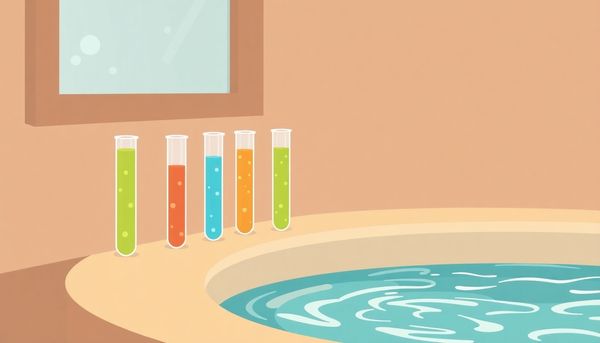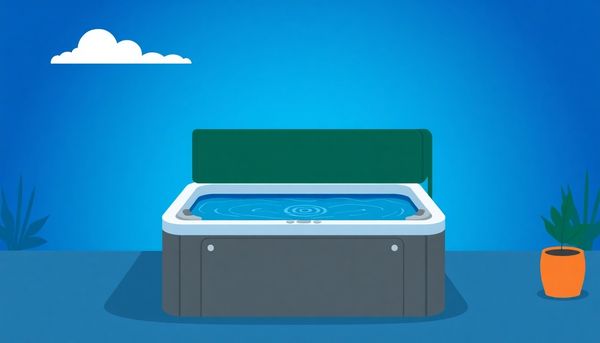Master Hot Tub Alkalinity: Essential Tips for Optimal Relaxation
January 12th, 2025
January 12th, 2025
Hot tubs offer a blissful retreat from the everyday hustle, a warm embrace that melts away stress. However, maintaining that perfect soak requires more than just filling it with water and turning on the jets. One crucial element often overlooked is the water's chemical balance, particularly its alkalinity. If you've ever found your hot tub water to be too acidic or your skin a bit irritated after a soak, it might be time to check those alkalinity levels.
In my own backyard oasis, I once faced the challenge of fluctuating pH levels, leaving me puzzled and my skin less than happy. A little research revealed that alkalinity acts as a stabilizer for pH, and without the right balance, you could be dealing with corrosion or scaling – neither of which are good news for your hot tub investment. Understanding this balance is vital for both the longevity of your tub and your personal comfort.
For those just stepping into the world of hot tub maintenance, adjusting alkalinity might seem daunting. But fear not; with the right approach, it's a straightforward process. This guide, complete with a helpful video, will walk you through the steps to ensure your hot tub remains a haven of relaxation. So, whether you're a newbie or a seasoned spa enthusiast, mastering alkalinity is within your grasp, ensuring every soak is as refreshing as the first.

Grabbing a bag of alkalinity increaser might not sound like the most thrilling task, but it can be a spa game-changer. Imagine relaxing in your hot tub, knowing the water isn’t just warm but perfectly balanced. Low alkalinity can sneak up like an uninvited guest, wreaking havoc by staining surfaces and damaging equipment. An alkalinity increaser acts like a steadfast guardian, ensuring your pH levels stay stable and your soak remains serene.
Remember the last time you adjusted anything in your hot tub and thought, "I hope this works"? Using an alkalinity increaser is straightforward, almost like following a simple recipe. It's designed to make things easy, with instructions right on the label. And if you're a fan of DIY solutions, good old baking soda can serve as an effective alternative. Just make sure it's pure sodium bicarbonate, free of any kitchen-grade extras.
A personal tip? Keep a chart handy to match your current alkalinity reading with the amount of increaser needed. It’s like having a trustworthy sidekick in your hot tub maintenance routine. And, for those of us who appreciate precision, test strips or a digital test kit can confirm that your adjustments are spot on. The peace of mind knowing your hot tub is in prime condition can make those relaxing moments even sweeter.
Understanding the precise alkalinity requirements for your hot tub is like ensuring the right balance of ingredients in a favorite recipe. Too much or too little can lead to an unpleasant experience. The baseline for any hot tub enthusiast is to maintain alkalinity between 100 and 150 parts per million (ppm). This range acts as a protective shield, preventing the pH from fluctuating wildly due to external factors like rain, temperature changes, or even the simple act of soaking.
Before adding any chemicals, it's crucial to know your tub's exact water volume. This knowledge is the foundation upon which correct dosage relies. Imagine scooping too much or too little baking soda into your tub because you guessed at its size—results vary from ineffective to potentially damaging.
Testing is your guiding star here. Employ test strips or a liquid test kit to get an accurate read on your water’s current alkalinity. While test strips provide a quick snapshot, a liquid kit offers precision that perfectionists might prefer. For those of us who are colorblind, a digital reader or the assistance of a friend can ensure accuracy.
When you've determined the deficiency, Alkalinity Increaser or plain baking soda becomes your best friend. Careful measurement and gradual addition are key; after all, patience and precision go a long way in crafting the perfect hot tub experience. Remember, a stable alkalinity means not only comfortable soaks but also the longevity of your spa investment.
Let’s talk about baking soda, the unsung hero of hot tub maintenance. When it comes to raising alkalinity, this common household item does more than just sit in your pantry. It's a straightforward, cost-effective solution for keeping your hot tub water perfectly balanced. On a chilly evening, I once found myself with a hot tub full of water that stubbornly refused to stay balanced. With a container of baking soda in hand, I discovered how effortlessly it can transform water chemistry. It's as simple as sprinkling a tablespoon per 100 gallons of water to increase alkalinity by 10 ppm.
So, why baking soda? This natural alkalinity booster, with its main ingredient, Sodium Bicarbonate, is not only effective but also gentle on your spa’s surfaces compared to harsher chemicals. However, ensure that the baking soda you use has no additives—just the pure stuff. It’s worth noting that while baking soda will nudge your pH up slightly, it won't drastically alter it, allowing for a smoother balancing act.
Once you've added the baking soda, patience is key. Give it about 15 minutes to work its magic, then retest the water. If you're like me, you'll find satisfaction in watching the numbers align perfectly on those test strips. By using baking soda effectively, you protect your hot tub’s components and ensure every soak is as comfortable as the last, without the worry of skin irritation or equipment damage. It's a simple tweak with significant benefits, and your hot tub will thank you for it.
The heart of your hot tub's health lies in its components, and safeguarding them should be a top priority. Each time you adjust the alkalinity, you're not just keeping the water crisp and clear—you're ensuring the longevity of your spa's inner workings. Low alkalinity can lead to corrosive water conditions, damaging essential parts like the heater, pumps, and jets. This wear and tear might not be visible immediately, but over time, the integrity of these components can be severely compromised.
Imagine discovering a heater malfunction after a long day, solely because the water chemistry was ignored. A friend once shared how neglecting alkalinity led to a costly repair. Their story serves as a reminder that regular maintenance is essential. Alkalinity acts as a cushion, preventing drastic pH shifts that could otherwise wreak havoc on your hot tub’s surfaces and parts.
Moreover, keeping the alkalinity between 100 and 150 ppm not only shields equipment but also enhances bather comfort. No one wants a soak ruined by itchy skin or red eyes. Properly balanced water chemistry, facilitated by using alkalinity increasers or baking soda, ensures a soothing experience.
In essence, protecting your hot tub components through vigilant alkalinity management saves you money, prolongs equipment life, and offers peace of mind. A little attention to detail today can prevent a multitude of issues tomorrow.

When dealing with the chemistry of your hot tub, baking soda emerges as an unexpected hero. It might seem like a humble kitchen staple, but when it comes to balancing your hot tub's alkalinity, sodium bicarbonate plays a starring role. Imagine you’re preparing to relax in your spa after a long day. You test the water, only to find the alkalinity is not quite where it should be. Enter baking soda, the simple solution to safeguarding both your skin and your spa.
Before you rush to add it, though, a little preparation goes a long way. Always start with clean, dry hands and consider wearing chemical-resistant gloves to protect your skin. Have a measuring spoon handy to ensure accurate dosing; typically, one tablespoon per 100 gallons of water will suffice to raise alkalinity by 10 ppm. Sprinkle the baking soda across the water’s surface evenly, avoiding dumping it all in one spot. This allows for a more uniform distribution and effective adjustment.
After adding the baking soda, patience is your ally. Wait about 15 minutes, then retest the alkalinity levels. This interval allows the solution to mix thoroughly with the water. If adjustments are needed, a little more baking soda can gently nudge the levels to the right spot. Your hot tub will thank you, not just by maintaining clean and clear water, but also by extending its lifespan, free from corrosive damage.
When it comes to maintaining your hot tub, understanding the role of an alkalinity increaser is essential. Consider alkalinity the unsung hero of water chemistry, a guardian that ensures pH levels stay in check. Without the right alkalinity, your pH could swing dramatically, wreaking havoc on comfort and equipment alike. An alkalinity increaser, often made of sodium bicarbonate, helps prevent these wild fluctuations.
Let’s say you’ve just tested your hot tub water and the alkalinity reads low. It’s time to act. Using an alkalinity increaser is straightforward but requires precision. Start by measuring your water’s current alkalinity using reliable test strips or a liquid kit. Refer to a dosage chart to determine how much increaser to add for your specific volume of water. This attention to detail is crucial to avoid over-correction, which can lead to other issues like cloudy water or scale build-up.
Once you've added the amount specified, circulate the water for at least 15 minutes to ensure even distribution. Retest the alkalinity to verify the adjustment. If needed, repeat the process, but always in small increments. This methodical approach ensures safe and effective water chemistry management, letting you relax in crystal-clear water without a worry. Remember, a balanced spa is a happy spa, and your skin will thank you for it.
Understanding the intricacies of maintaining your hot tub's alkalinity begins with precise testing. Think of it as a health check-up for your spa. The road to achieving a blissfully balanced hot tub environment starts with knowing exactly where your current levels stand. This is where test strips or liquid test kits come into play. Personally, I have found test strips to be a real time-saver for quick assessments. They’re straightforward to use—just dip and compare the colors to the chart provided. However, if you're aiming for pinpoint accuracy, a liquid test kit is your best friend, offering a detailed breakdown of your water's chemistry.
Imagine you're hosting a weekend soak session; you definitely want your hot tub's alkalinity within the optimal range of 100 to 150 ppm. This prevents those pesky pH swings that can make your water uncomfortable and equipment prone to damage. Before you reach for that Alkalinity Increaser or baking soda, though, make sure you've accurately measured your hot tub's water volume. It sounds basic, but getting this wrong could lead to incorrect dosing. And if colors aren't your forte (hello, fellow colorblind folks), don’t hesitate to enlist a helper or use a digital reader for precision.
Remember, once you’ve tested, let your hot tub settle for about 15 minutes before retesting post-treatment. This patience ensures the adjustments have fully integrated, giving you a clear picture of your success. Balancing your hot tub’s water might seem a chore, but accurate testing lays the foundation for a soothing spa experience.
When it comes to your hot tub, there's more at stake than just a relaxing soak. Properly managing the alkalinity is key not only for a soothing experience but also for safeguarding both your skin and the hot tub machinery. Poorly balanced water can be a silent saboteur. If the alkalinity veers too low, it disrupts the pH, leading to corrosive water that can harm metal components and leave skin feeling dry and itchy. On the flip side, overly high alkalinity can result in murky water and irritating calcium deposits, detracting from your hot tub enjoyment.
Consider the time I once overlooked this essential maintenance step. I found myself dealing with a faulty pump and a slew of skin irritations after an innocent weekend soak turned problematic. Tossing in an alkalinity increaser, or even a dash of sodium bicarbonate—good old baking soda—can prevent such headaches. However, always ensure the baking soda is pure, without extras like anti-caking agents. By adding just a tablespoon per 100 gallons of water, you increase alkalinity by 10 ppm, keeping your hot tub and skin in harmony.
The next time you’re ready to unwind, make sure your hot tub water is impeccable. It’s not just about immediate enjoyment but also about preserving the longevity of your spa and the health of your skin. A little attention to detail can keep both you and your hot tub glowing.

Ever tried baking a cake without measuring the ingredients? Balancing your hot tub’s pH and alkalinity can feel just as puzzling, but with a little guidance, it becomes as straightforward as following a recipe. Your hot tub's alkalinity is like a dependable friend, keeping the pH stable and preventing those annoying fluctuations. When alkalinity is low, pH levels swing wildly, leading to a host of issues such as skin irritation, equipment corrosion, and cloudy water. A balanced alkalinity, however, acts as a cushion, safeguarding against these problems.
In my own backyard, after a heavy rain, I noticed the water looking a bit off. Armed with test strips, I quickly realized the alkalinity had dipped. A scoop of baking soda later, and the water was back to its sparkling self. It’s amazing what a little sodium bicarbonate can do! Typically, you’d use an alkalinity increaser for this job, but in a pinch, baking soda is a trusty alternative. Just ensure it’s free from additives.
Remember, maintaining your hot tub isn't just about aesthetics; it's about creating a safe, enjoyable environment. Test your water regularly, adjust as necessary, and your hot tub will reward you with countless relaxing soaks. With your pH and alkalinity in harmony, you’ll extend the life of your spa and enhance every bubble-filled moment.
Handling alkalinity increasers safely in your hot tub is as crucial as choosing the right ones. Think of it as cooking with powerful spices—using just the right amount makes all the difference. When adding chemicals like an alkalinity increaser or even baking soda, it's essential to follow precise measurements outlined on the packaging or use a reliable chart to determine the needed amount based on your current readings. This ensures your hot tub remains a sanctuary rather than turning into a chemistry experiment gone awry.
My friend once underestimated the potency of these chemicals and ended up with a foamy mess that was more akin to a bubble bath than a relaxing soak. To avoid such sticky situations, always wear chemical-resistant gloves and protective goggles during handling. These simple precautions keep your skin and eyes shielded from possible irritation, much like wearing gloves while chopping hot peppers.
Remember, patience is your ally. After adding the increaser, allow the water to circulate for at least 15 minutes before retesting the alkalinity levels. This waiting period is akin to letting a freshly baked cake cool—rushing it could lead to skewed results. If needed, make small, incremental adjustments rather than large leaps, ensuring a balanced and safe hot tub experience. By respecting these steps, you not only protect your hot tub but also guarantee every dip is soothing and stress-free.
Using baking soda to balance your hot tub's pH is like wielding a secret weapon against water imbalance. One evening, as I watched the steam rise gently from my bubbling hot tub, I realized how vital it was to maintain the water's alkalinity. It wasn’t just about comfort; it was about protecting the equipment and ensuring the disinfectants worked effectively. Baking soda, or sodium bicarbonate, emerged as a simple and effective solution.
The chemistry behind it is surprisingly straightforward. By adding one tablespoon (17 grams) of baking soda per 100 gallons (379 liters) of water, you can increase the alkalinity by 10 parts per million (ppm). This simple adjustment acts as a buffer for your pH levels, helping to prevent the wild fluctuations that can lead to corrosion or scaling. While adding the baking soda, I always chuckle at how such an ordinary kitchen staple can play such an extraordinary role in hot tub care.
However, precision is key. It’s important to ensure the baking soda you use is pure, without any additives that might cloud your water. After mixing, wait for about 15 minutes, then retest to confirm the changes. This practice has become my go-to ritual, ensuring that my hot tub remains a haven of relaxation and not a source of irritation. A well-maintained pH not only protects your skin but also keeps your spa's internal components in tip-top shape, promising many more serene soaks in the future.
Understanding water chemistry in your hot tub might sound daunting, but it’s a task well worth your attention. Let's start with the basics. Having an accurate read on your hot tub's alkalinity and pH levels is crucial because it directly affects the comfort and safety of your soak. Imagine soaking in water that's either too acidic or too basic – neither is a pleasant scenario. Ensuring your water is balanced not only enhances your hot tub experience but also extends the life of your equipment.
When it comes to testing, options abound. Many prefer test strips for their simplicity and speed; just a quick dip, and you have a spectrum of data at your fingertips. These strips provide insights into several key factors, such as total hardness, chlorine levels, and, importantly, alkalinity. But for those who value precision, a liquid test kit with a digital reader might be more your speed. While they require a bit more effort, they offer a more exact measure of your water chemistry, ensuring you can make informed decisions.
After gathering your data, the real work begins. Adjustments may be needed, and understanding how each chemical affects your hot tub's chemistry is vital. Raising alkalinity, for instance, can also nudge your pH levels slightly upward, so keep this interplay in mind. Regular testing and monitoring create a rhythm, a routine that keeps your hot tub in optimal condition, ready for a relaxing soak whenever you are.

Testing the water in your hot tub isn't just a routine—it’s an essential ritual that ensures your oasis remains a pleasant and safe retreat. Armed with the right tools, water testing becomes a breeze. Test strips are the go-to for many due to their convenience and speed. With a simple dip and a few seconds of wait time, you’ll have a snapshot of your hot tub’s chemistry, including total alkalinity, pH, and sanitizer levels. However, if precision is your calling, a liquid test kit might be your best ally. Though it demands a bit more effort, the accuracy it offers can be invaluable, particularly for those who wish to fine-tune water balance to perfection.
Understanding your hot tub’s water capacity is crucial before diving into testing. Knowing the exact number of gallons or liters allows for more accurate chemical adjustments. If you're colorblind or if the color gradients on test strips seem too subtle, enlisting a friend becomes a smart choice. Alternatively, digital test kits can offer clarity without the guesswork, providing digital readouts that skip the color matching process altogether.
Routine checks should become second nature, particularly after prolonged use or extreme weather. A quick test post-soak ensures that any shifts in water chemistry are promptly addressed, keeping your tub not only inviting but also a sanctuary of relaxation and rejuvenation.
Balancing alkalinity in your hot tub isn't just about keeping things steady—it's about ensuring your relaxation haven remains inviting and safe. If you’ve ever noticed your hot tub water looking a bit off or felt your skin reacting after a soak, chances are your alkalinity levels might be to blame. Alkalinity acts as a protective buffer for pH levels, helping them stay in the Goldilocks zone—not too high, not too low.
Think of alkalinity as the unsung hero that absorbs the everyday stressors your tub faces. From the oils and lotions on your skin to the chlorine doing its job, these elements can throw pH levels into disarray. By maintaining proper alkalinity, you create a fortress around your pH, allowing it to remain stable despite these influences.
Years ago, I faced a mysterious corrosion problem with my hot tub's metal fixtures. It took a bit of detective work, but I realized the culprit was low alkalinity. Since then, I’ve made it a habit to check alkalinity levels regularly. Whether you prefer using alkalinity increaser products or simply sticking with trusty baking soda, knowing the right amounts to add based on your water's current state can save you from potential repair headaches. Remember, keeping your alkalinity in check is more than a maintenance task—it's the foundation of a harmonious hot tub experience.
When it comes to ensuring your hot tub's alkalinity is in the perfect range, it all begins with choosing the right testing method. Each method has its pros and cons, and selecting the most effective one can save you time, money, and unnecessary frustration. In my experience, test strips are the go-to for quick checks. They're like having a handy detective kit—just dip and compare the colors. However, if precision is your mantra, a liquid test kit might be your new best friend. Though it requires a little more effort, this method provides accurate results that can be crucial for maintaining the delicate balance of your hot tub’s water chemistry.
For those who appreciate the convenience of technology, digital readers paired with liquid kits offer an innovative twist. These devices take the guesswork out of color matching and provide a straightforward numerical reading. It’s like having a personal lab technician right at home. On the other hand, if you’re someone who enjoys a more traditional approach, sticking with manual kits could be both satisfying and effective.
Remember, the key to effective testing is consistency. Regularly checking your hot tub's alkalinity ensures you're always a step ahead of potential issues. Whether it's a casual weekend dip or a daily ritual, having balanced water is essential for an enjoyable and safe hot tub experience.
When handling chemicals to adjust your hot tub's alkalinity, following safe practices is paramount. Begin with the basics: always read the labels and instructions on any product you're using, whether it's an Alkalinity Increaser or simple baking soda. These directions not only ensure effectiveness but also keep you and your tub safe from mishaps.
It’s wise to dress the part when working with these substances. Slip on a pair of chemical-resistant gloves to protect your hands from irritation. Goggles can also shield your eyes from accidental splashes, which, believe me, can happen when you least expect it. Imagine you're about to pour a carefully measured scoop of baking soda, and a gust of wind decides to give you a surprise – better safe than sorry!
Another tip is to ensure your workspace is well-ventilated. Fumes from some chemicals might not be evident at first sniff, but prolonged exposure can lead to discomfort. If you're adding chemicals indoors or in an enclosed area, crack a window or turn on a fan.
Lastly, when measuring and adding these products, use dedicated tools to avoid cross-contamination. Keep a clean scoop or measuring cup specifically for your hot tub needs. Maintaining these practices not only helps in achieving the desired alkalinity levels but also prolongs the life of your hot tub equipment. Stay safe and happy soaking!

When it comes to maintaining your hot tub, safeguarding the equipment is just as crucial as enjoying a relaxing soak. The delicate balance of alkalinity plays a significant role in this. Think of alkalinity as the shield for your hot tub’s components; without it, your pH levels could swing unpredictably, leading to corrosion and costly repairs. A low alkalinity level not only destabilizes pH but also threatens the health of your hot tub’s metal parts and surfaces.
Consider this: your hot tub, much like any cherished possession, deserves protection from premature wear. Alkalinity acts as a buffer, preventing pH from taking wild shifts due to changes in the environment—whether that be the introduction of bathers, chemical additions, or even a sudden rain shower. This stability is essential because it stops acidic water from corroding the metal heaters and pumps that keep your spa running smoothly.
To ensure your hot tub's longevity, regularly test and adjust the alkalinity. Use tools like test strips or a digital liquid test kit to monitor the levels. Once you find the alkalinity lacking, reach for an Alkalinity Increaser or baking soda to bring it back within the safe range of 100 to 150 ppm. By doing so, you are not just preserving your hot tub’s aesthetic appeal but also its mechanical heart, ensuring countless trouble-free soaks in the future.
Balancing the pH and alkalinity in your hot tub is akin to keeping a fine-tuned instrument in harmony. Imagine soaking in your hot tub, only to discover that your skin feels itchy and the water looks cloudy. This could be a sign of an imbalance in pH or alkalinity, both of which play pivotal roles in maintaining the perfect hot tub experience.
While pH measures the acidity or basicity of your water, alkalinity acts as a safeguard, ensuring that the pH remains stable. Think of alkalinity as a cushion, absorbing the shocks of various influences like body oils, lotions, or even the occasional rainwater that sneaks in when you forget the cover. A dip in alkalinity can lead to erratic pH levels, causing discomfort and potential damage to your hot tub's components.
On a personal note, I've found that using an Alkalinity Increaser simplifies the process tremendously, especially when you're juggling a busy schedule. Baking soda, or sodium bicarbonate, offers an easy-to-find alternative, just ensure there are no added ingredients that could throw off your balance. Each tablespoon can raise alkalinity by 10 ppm, and while it’s tempting to eyeball it, precise measurement is key.
Remember, keeping your pH between 7.4 and 7.6 with alkalinity between 100 and 150 ppm ensures a comfortable soak and extends the life of your spa. Regular testing with either strips or liquid kits helps avoid surprises, making sure your relaxation sanctuary remains just that.
Choosing the right tools to test your hot tub’s alkalinity can feel like navigating a maze, yet it’s an essential step in maintaining a balanced spa environment. Test strips and liquid test kits are the go-to options for spa enthusiasts. Though test strips offer convenience, akin to a quick snapshot, they might not capture every detail. For a more precise assessment, liquid test kits come into play, with their meticulous droppers and color comparisons, allowing for a deeper dive into your tub’s chemistry.
When I first started managing my own hot tub, I leaned toward test strips due to their ease of use. A quick dip and a glance at the color chart seemed straightforward. However, as my interest in water chemistry grew, I found myself gravitating toward liquid test kits. Their ability to pinpoint specific levels gave me more confidence in adjusting the alkalinity precisely.
For those with color vision deficiencies, these tasks can pose additional challenges. A digital test kit can be a game-changer, providing clear readings without the ambiguity of color interpretation. Alternatively, a trusted friend can assist with reading the results, ensuring accuracy.
No matter the method you choose, committing to regular testing is vital. Just like a trusted friend who alerts you to changes, these tools ensure your hot tub remains a sanctuary of relaxation, free from the woes of unbalanced water.

This article provided insights into maintaining your pool. Start your pool care journey today!
Want to become a pool maintenance expert? Our free Pool School course covers everything you need to know about pool care. From basic maintenance to advanced troubleshooting, you'll learn how to:
Join over 10,000 pool owners who have already transformed their pool care routine. Get started with our free Pool School course today!